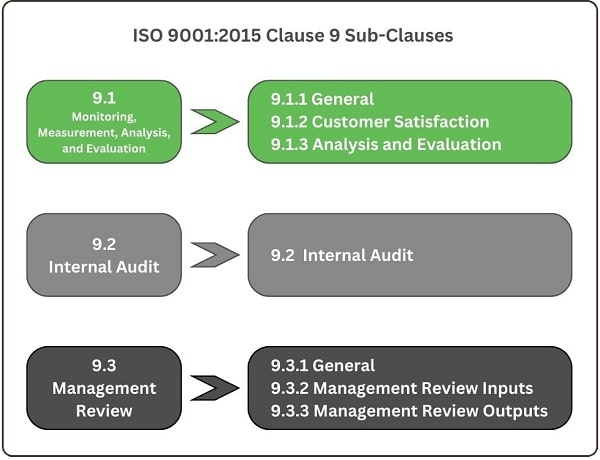ISO 9001:2015 Clause 9
What is the ISO 9001:2015 Clause 9 About?
Clause 9 of the ISO 9001:2015 standard, titled “Performance Evaluation,” serves the purpose of establishing requirements for monitoring, measuring, analyzing, and evaluating the performance of a quality management system (QMS). The overall purpose of this clause is to ensure that organizations have effective processes in place to assess the performance of their QMS, identify areas for improvement, and make informed decisions based on objective data.
Clause 9 emphasizes the importance of evidence-based decision-making and continual improvement. It ensures that organizations have mechanisms in place to gather relevant data, assess performance, identify areas of non-conformity, and implement corrective actions. By monitoring and evaluating the QMS, organizations can drive continual improvement, enhance customer satisfaction, and achieve their quality objectives.
The Specific Objectives of Clause 9, Performance Evaluation, are as follows:
Monitoring, Measurement, Analysis, and Evaluation:
Organizations must establish processes for collecting and analyzing data to evaluate the performance and effectiveness of the QMS. This includes monitoring key performance indicators (KPIs), conducting measurements, and analyzing data to assess trends, identify areas of non-conformity, and evaluate the performance of processes.
Get a Free Quote
Internal Audit:
The clause requires organizations to conduct internal audits of their QMS to determine its conformity and effectiveness. Internal audits are independent assessments carried out by competent personnel to verify compliance with the QMS requirements, identify nonconformities, and recommend corrective actions.
Management Review:
Organizations must conduct periodic management reviews to evaluate the performance of the QMS. Management reviews involve top management assessing the suitability, adequacy, and effectiveness of the QMS, considering changes in the organization’s context, and making decisions regarding resource allocation, improvement opportunities, and future directions.
Evaluation of Compliance:
Organizations are required to evaluate their compliance with applicable legal, regulatory, and contractual requirements. This involves establishing processes to identify and assess legal and regulatory requirements, ensuring conformity to those requirements, and maintaining records of compliance.
Nonconformity and Corrective Action:
The clause emphasizes the importance of identifying and addressing nonconformities systematically. Organizations must establish processes for capturing nonconformities, determining their root causes, implementing corrective actions to prevent recurrence, and verifying the effectiveness of those actions.
By addressing the objectives of Clause 9, organizations establish a framework for evaluating the performance and effectiveness of their QMS. The monitoring, measurement, analysis, and evaluation activities help organizations identify areas of improvement, detect trends, and take proactive actions to enhance their processes, products, and services.

Complying with Clause 9
Complying with Clause 9, titled “Performance Evaluation,” in the ISO 9001 Standard involves establishing processes to monitor, measure, analyze, and evaluate the performance of the quality management system (QMS). Here are some examples of how an organization can comply with Clause 9:
1. Internal audits:
Conduct regular internal audits to assess the effectiveness of the QMS and identify areas for improvement. Develop an audit program, define audit criteria, and select competent auditors to perform objective evaluations of QMS processes and their compliance with requirements.
2. Monitoring customer satisfaction:
Implement methods to gather feedback from customers regarding their satisfaction with the organization’s products or services. This may involve surveys, feedback forms, customer reviews, or other means of capturing customer perceptions.
3. Analysis of data:
Collect and analyze relevant data to evaluate the performance of the QMS and identify trends, opportunities for improvement, and areas of non-conformance. Use statistical techniques and data analysis methods to draw meaningful conclusions and support decision-making.
4. Management review:
Conduct regular management review meetings to assess the overall performance of the QMS. Evaluate the achievement of quality objectives, review audit results, analyze data, and discuss opportunities for improvement. Ensure that appropriate actions are identified and assigned for implementation.
5. Monitoring of processes:
Establish methods to monitor key processes within the QMS to ensure they are operating effectively and meeting defined objectives. Use performance indicators, such as process cycle time, defect rates, or customer complaints, to track process performance and identify areas that require attention.
6. Evaluation of suppliers:
Evaluate the performance of suppliers and contractors to ensure they meet the organization’s quality requirements. This may involve conducting supplier audits, assessing delivery performance, monitoring product/service quality, and addressing any nonconformities or issues identified.
7. Risk assessment and management:
Continually assess and manage risks that may affect the performance of the QMS. Identify potential risks, analyze their impact, and implement appropriate controls and mitigation strategies. Regularly review risk assessments to ensure their effectiveness and adapt as needed.
8. Calibration and measurement:
Establish procedures for the calibration and verification of monitoring and measuring equipment used to assess product or process conformity. Ensure that equipment is regularly calibrated, traceable to national or international standards, and properly maintained.
9. Analysis of nonconformities:
Analyze nonconformities, including customer complaints, internal nonconformities, and audit findings, to identify their root causes. Implement corrective and preventive actions to address identified issues and prevent recurrence.
10. Continual improvement:
Foster a culture of continual improvement by promoting the use of performance data and analysis to identify opportunities for enhancing the QMS. Encourage employees to provide suggestions for improvement, implement improvement projects, and monitor the effectiveness of implemented actions.
Compliance with Clause 9 ensures that the organization evaluates the performance of the QMS, identifies areas for improvement, and takes appropriate actions to enhance its effectiveness. By conducting internal audits, monitoring customer satisfaction, analyzing data, performing management reviews, assessing supplier performance, managing risks, evaluating nonconformities, and promoting continual improvement, organizations can drive the ongoing development and success of their QMS.
A History of Clause 9 of the ISO 9001 Standard
Clause 9 of the ISO 9001 standard, titled “Performance Evaluation,” has evolved throughout the history of the standard. Let’s explore the changes and developments in Clause 9 over the different versions of ISO 9001:
ISO 9001:1987:
The initial version of ISO 9001, published in 1987, did not have a dedicated clause for “Performance Evaluation.” The standard primarily focused on quality assurance and control processes, without explicitly addressing the systematic evaluation of performance within a quality management system (QMS).
ISO 9001:1994:
In the 1994 revision, ISO 9001 introduced the concept of a “Quality System” in Clause 4. While it addressed some aspects of performance evaluation, there was no dedicated clause specifically addressing this topic.
ISO 9001:2000:
The year 2000 brought significant changes to ISO 9001, including the introduction of the High-Level Structure (HLS) developed by ISO. Clause 8, titled “Measurement, Analysis, and Improvement,” was introduced to address the performance evaluation aspects of the QMS. It included requirements related to monitoring, measurement, analysis, and improvement of the QMS processes.
ISO 9001:2008:
The 2008 revision introduced Clause 8.2.1, titled “Customer Satisfaction,” which required organizations to monitor and measure customer satisfaction as one aspect of performance evaluation. Additionally, Clause 8.4, titled “Analysis of Data,” included requirements related to the analysis of data to evaluate the QMS performance.
ISO 9001:2015:
The 2015 revision of ISO 9001 brought significant changes to Clause 9. It was restructured and expanded to provide a more comprehensive approach to performance evaluation within the QMS. The revised clause, titled “Performance Evaluation,” includes requirements related to monitoring, measurement, analysis, and evaluation of the QMS.
ISO 9001:2015 introduced specific sub-clauses under Clause 9, including:
Clause 9.1 Monitoring, measurement, analysis, and evaluation
Clause 9.2 Internal audit
Clause 9.3 Management review
The current version of ISO 9001, ISO 9001:2015, places significant emphasis on performance evaluation as a key aspect of the QMS. It requires organizations to establish systematic processes for monitoring, measuring, and analyzing various aspects of the QMS performance. This includes evaluating customer satisfaction, assessing process performance, analyzing data, conducting internal audits, and conducting management reviews.
By incorporating performance evaluation requirements, ISO 9001:2015 ensures that organizations have mechanisms in place to assess the effectiveness of their QMS and identify opportunities for improvement. It emphasizes the importance of data-driven decision-making, continual monitoring of performance indicators, and periodic reviews to drive performance improvement and meet customer requirements.
Overall, Clause 9, Performance Evaluation, in ISO 9001:2015 recognizes the significance of evaluating the QMS performance to drive continual improvement. It helps organizations establish robust performance measurement practices, conduct objective assessments, and use data-driven insights to enhance their processes, products, and services.
Consulting Support for ISO 9001
Every year, we help hundreds of small businesses achieve ISO 9001 certification. Support for ISO 9001 is available through any of our Consulting Programs
As an American business with a story like yours, we know that time is valuable. Our expert consultants are here to take on the difficult, technical aspects of certification so you can focus on your business. They’ll work with you every step of the way until you’re successfully certified.
Interested? Get a Free Quote.
In many industries, ISO 9001 has become a supply-chain requirement. When landing a big contract, ISO 9001 certification could make all the difference.

About Core Business Solutions
"Core Business Solutions was started by my brother, Mike Dawson, and myself, true entrepreneurs at heart looking for a better way to make a living and help small businesses improve the quality of the products and services they provide.
The bottom line: we are real people that have developed a team to come along side you to help you grow and succeed."
-- Scott Dawson, President
Related Standards
We provide consulting support for various other standards, as well as support for companies seeking multiple certifications through an Integrated Management System.
AS9100
Aerospace Manufacturers
AS9120
Aerospace Distributors
ISO 14001
Environmental Management Systems
ISO 27001
Information Security Management Systems
ISO 20000-1
Service Management Systems
ISO 45001
OH&S Management Systems
ISO 13485
Medical Device Manufacturers
AS9100
AS9120
ISO 14001
ISO
20000-1
ISO 27001
ISO 45001
ISO 13485
Equip Your Business to Meet ISO 9001 With CORE
At Core Business Solutions, we’re here to equip your company for success in meeting ISO 9001 requirements. We’ve helped hundreds of small businesses grow and deliver the best solutions to their clients. We provide ISO training services, consulting help, and compliance software and to help you get certified and stay certified. We focus on optimizing your processes and helping you implement an ISO-compliant QMS. When you partner with us, you’ll get the tools and help you need for success.
For more information on the ISO 9001:2015 standard, please visit our articles page. You can also call our consulting office at 866-354-0300.
Do you want to update your existing ISO 9001 QMS System or refresh it?
We provide consulting services to assist you in your ISO 9001 Quality Management System refresh. We listen, conduct a gap analysis, update your Quality Policy and any necessary documentation or procedures, find areas of waste or improvement, simplify and automate. And we do it fast. Core offers firm, fixed pricing. Download our information sheet today to learn more or call us at 866-354-0300 Extension 2.
